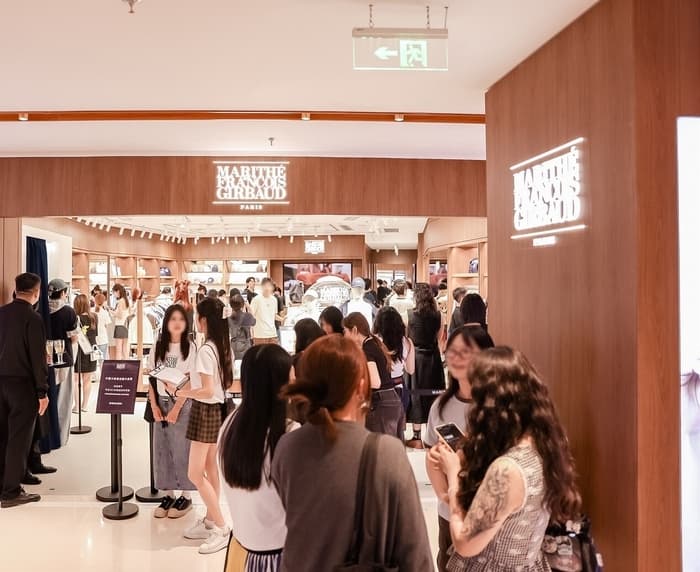A new playbook for Hallyu in China
For years, K beauty products were the standard bearers of Korean soft power in China. That balance is shifting. Fashion is now stealing the spotlight among younger Chinese consumers, and the numbers back it up. According to Korea Customs Service data, South Korean apparel exports to China climbed about 45 percent, from 375 million dollars in 2020 to roughly 545 million dollars in 2024. New Korean labels, well known in Seoul’s trend districts and on social media, are gaining traction in China’s largest cities. They bring clean silhouettes, accessible prices, and a steady flow of celebrity and influencer moments that keep products visible and desirable.
- A new playbook for Hallyu in China
- Why K fashion is gaining traction with Chinese Gen Z
- The brands moving fastest
- Musinsa and Anta bet big on China
- Retailers double down on local partners and playbooks
- Why K beauty lost steam, and what fashion learned
- Risks and realities in China’s fashion market
- What success will look like
- Key Points
The flip side is cosmetics. Even as total Korean cosmetics exports hit a record in the first three quarters of this year, China is no longer the top destination for those goods. The United States accounted for 19.6 percent of shipments, while China took 18.6 percent. In 2021 China represented nearly half of Korean cosmetics exports. Beauty leaders have responded by reshaping China strategies, closing physical stores, leaning on online commerce, and redirecting resources to North America and Europe. Fashion players, watching those moves, are building their own China plans with lessons learned from K beauty’s challenges.
Why K fashion is gaining traction with Chinese Gen Z
China’s Gen Z gravitates to styles that feel global yet adaptable to local culture. Streetwear, sportswear, and refined basics check those boxes. Korean brands hit a sweet spot between minimal and expressive. They produce frequent drops, use playful logos sparingly, and elevate everyday garments with neat fits and subtle details. These are easy to mix with local favorites and luxury pieces, which suits a consumer who assembles looks across price tiers.
Social media accelerates that cycle. What a K pop idol wears in a teaser image can spark instant searches on Douyin and Xiaohongshu. A rising futuristic aesthetic known as Y3K, with metallic tones and tech inspired styling, began in Korea and has picked up speed in China’s feeds. Nostalgic 1990s and 2000s references also resonate. The result is a constantly moving style conversation in which Korean brands often appear early and in sync with how young Chinese dress right now.
Platforms and KOLs matter
Winning attention in China requires fluency in digital platforms. Tmall and JD handle the heavy lifting of online retail at scale. WeChat is the center of community building and customer service. Xiaohongshu and Douyin are where tastes are formed and validated. Collaborations with credible creators, known locally as KOLs, shape discovery and trust. A localized content strategy, native language customer support, and fast fulfillment are no longer optional. Korean companies that got this formula right at home can adapt it for China, but the speed and norms of engagement are different and require local teams.
The brands moving fastest
A cluster of contemporary Korean labels has moved into China with clear positioning. Mardi Mercredi entered in 2023 and now counts around ten stores through a distribution partnership with Mist Holdings. Marithe Francois Girbaud, operated by Korean firm Layer under an Asia wide license, opened its first Shanghai location in July and plans to open more in major cities. Matin Kim, a favorite among Gen Z and millennial shoppers across Asia, has prepared for mainland entry after opening outlets in Japan, Hong Kong, Taiwan, and Macao.
Momentum for Matin Kim is not just buzz. Annual revenue reached about 128.8 billion won, with operating profit rising to 38.7 billion won from 20.6 billion won. The brand’s track record has sparked competition among Korean retailers to secure China distribution rights. Players such as Musinsa, Kolon FnC, E Land, and Misto Holdings see China as too consequential to ignore. Their strategies combine flagship stores in high traffic districts with curated multibrand spaces and pop ups that turn social attention into store traffic.
From logo staples to sleek basics
Early K fashion in China skewed toward recognizable logo items. The current wave balances brand visibility with wearability. The focus tilts toward refined tees, trousers, outerwear, and accessories that become daily uniform pieces. This helps with repeat purchases and reduces overreliance on one hit item. It also makes collaboration easier, since clean canvases pair well with capsule graphics and limited color stories that create urgency without overcomplicating inventory.
Musinsa and Anta bet big on China
Musinsa, South Korea’s leading fashion platform and owner of the Musinsa Standard label, is placing a large strategic bet on China through a joint venture with Anta Sports. The structure gives Musinsa a 60 percent stake and management control, with Anta taking 40 percent and providing scale in distribution and retail operations. The first Musinsa Standard store in China is set to open in mid December on Shanghai’s Huaihai Road inside Parkson Shopping Mall. The location is about 1,300 square meters, linking with a Tmall flagship to offer integrated online to offline services. A multibrand Musinsa Store is also planned for Anfu Road, a neighborhood known for pop ups and design led retail. The company’s goal is more than 100 China stores by 2030 and over 1 trillion won in cumulative sales. Chinese customers have already been testing the product in Korea, where they made up 18.4 percent of foreign purchases at Musinsa Standard stores in May.
Anta brings experience operating large brand portfolios and one of China’s strongest retail networks. The partnership gives Musinsa local muscle in merchandising, logistics, and omnichannel operations. It also aligns with a broader convergence of sportswear and lifestyle fashion, where everyday basics and athletic inspired design overlap.
Wu Yonghua, co CEO of Anta Sports, framed the deal as a way to serve China’s younger consumers with a richer mix of fashion and sport.
By integrating sportswear with fashion forward design, we aim to better meet the preferences of China’s younger generation. Leveraging our full value chain capabilities and proven Brand plus Retail operating model, Anta Sports will empower Musinsa China to introduce Musinsa Standard and Musinsa Store to the market.
Joonmo Park, CEO of Musinsa, said the companies will combine strengths to reach new shoppers and support more Korean designers in China.
This partnership will combine Musinsa’s experience in fashion with Anta’s brand and retail management capabilities to tap into various retail channels and deliver differentiated brand experiences to Chinese consumers. We look forward to capturing the attention of young consumers in the dynamic Chinese market.
Retailers double down on local partners and playbooks
Partnerships with Chinese operators have proven effective for Korean brands that want scale and resilience. Kolon Sport established Kolon Sports China with Anta in 2017 and has seen revenue in China rise from about 70.3 billion won in 2021 to 503.2 billion won last year. The model leverages local store operations, real estate access, and marketing know how, while the Korean side focuses on brand identity and product development.
Distribution deals are common at the label level. Mardi Mercredi works with Mist Holdings to run stores and manage local retail execution. Layer brought Marithe Francois Girbaud to Shanghai under a regional license. These arrangements allow faster rollouts and help brands avoid building proprietary networks before they know their repeat rate and city level preferences. Prime locations like Huaihai Road and Anfu Road in Shanghai act as visibility engines, drawing both resident shoppers and domestic travelers who track store openings on Xiaohongshu.
Digital muscle is the difference
Success in China depends on execution across marketplaces and social platforms. A strong Tmall presence, smart use of JD, and 1 to 1 engagement on WeChat are foundational. Douyin and Xiaohongshu drive inspiration and authenticity checks. KOL collaborations, short video content, and limited drops power discovery. Korean brands that tune fit, sizing, and price points to Chinese preferences, and that respond quickly through live streaming and chat, convert attention into sales. A data driven approach to trend spotting and inventory planning, the kind that helped Musinsa at home, can reduce markdown risk in a market where styles move quickly.
Why K beauty lost steam, and what fashion learned
The cooling of K beauty in China has roots in geopolitics, competition, and consumer mood. After the deployment of a missile defense system in Korea in 2017, China informally restricted some Korean cultural content. Beauty brands also faced a surge of capable Chinese competitors, many of which compress product cycles from concept to launch in a few months. Counterfeit products eroded trust for certain SKUs, and promotional spending became more expensive. Even with record global exports, China’s share of Korean cosmetics shipments dropped, while the United States took the lead at 19.6 percent versus 18.6 percent for China. Some Korean leaders closed physical stores in China and shifted to online only models. One large household goods and beauty group booked its first quarterly loss in about twenty years during the second quarter, a sign that the portfolio needed a reset.
Recent data shows hints of stabilization for some Korean beauty lines in China, especially through Douyin live commerce and localized product relaunches. The bigger lesson for fashion is clear. Diversify channels, build local communities in social apps, monitor price integrity, and keep a flexible launch calendar. Avoid overdependence on celebrity endorsements. Proof of concept in online commerce and high street flagships, backed by service and fit that resonate locally, gives a stronger foundation than a single category hit.
Risks and realities in China’s fashion market
Competition is intense. Domestic groups with national networks and a deep bench of brands, including sports oriented names, command top positions across malls and digital platforms. Many of China’s leading retailers are homegrown, and consumer pride in local brands is strong. Korean labels must earn space on the rack and in the feed, and they must do it with products that fit local climate, sizing, and color preferences.
Speed and compliance are part of the operating reality. Inventory turns need to match a fast moving market. Pricing must balance accessibility with brand value, since discount culture can dilute positioning. Local regulations on advertising, labeling, and data require attention. Intellectual property enforcement is better than it was a decade ago, yet vigilance on trademarks, lookalikes, and marketplace monitoring remains vital.
Macro risk still counts. A past attempt by a major Korean casual label to scale in China fell short during a period of political friction. The current cycle looks different. Korean companies are entering with joint ventures, licensed operations, and pilot stores that limit downside while testing demand. The depth of Chinese e commerce, combined with offline stores that deliver service and fit, reduces dependence on any one channel.
What success will look like
Store openings in Shanghai are only the start. Conversion rates, repeat purchases, and customer lifetime value will matter more than crowd photos on opening weekend. Strong sell through on core basics, steady replenishment, and tight markdown discipline will point to healthy demand. Live commerce events that move product without heavy incentives will indicate that brand value is intact. Collaborations with Chinese creators and brands that feel authentic, not opportunistic, will show that a label understands local culture.
Cross border signals will also help. Chinese shoppers have already sought out Musinsa Standard stores in Korea, which suggests pent up demand for the concept at home. If that shopper later visits a store on Huaihai Road or Anfu Road and recognizes the same fit and quality, omnichannel strategy is working. Over time, more brands can follow the same path, with licenses where needed and full control where the playbook is proven.
Key Points
- South Korean apparel exports to China rose from 375 million dollars in 2020 to about 545 million dollars in 2024, a gain of roughly 45 percent.
- K beauty’s share in China has slipped, with the United States now taking a larger portion of total Korean cosmetics exports.
- Musinsa and Anta launched a joint venture. The first Musinsa Standard store in China opens in mid December in Shanghai, with a multibrand Musinsa Store to follow.
- Musinsa targets more than 100 China stores by 2030 and over 1 trillion won in cumulative sales, supported by Tmall and offline integration.
- Mardi Mercredi, Marithe Francois Girbaud, and Matin Kim are expanding through local partners and licenses, with Matin Kim posting strong revenue and profit growth.
- Kolon Sport’s China business expanded rapidly after teaming with Anta, highlighting the role of local partners.
- Digital execution on Tmall, JD, WeChat, Douyin, and Xiaohongshu, plus KOL collaborations, is central to growth.
- Fashion brands are applying K beauty lessons in China: diversify channels, localize, track counterfeits, and avoid overreliance on one hit product.












